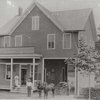Mackay negotiates size cap in New Scotland
NEW SCOTLAND Town board members are negotiating the details of the latest incarnation of a bill that would limit the size of retail development.
The last version of the bill met with defeat about a year ago since a supermajority, or four of the five board members, was required to pass the bill after owners of land in the commercial zone filed a protest petition.
The three board members who were elected two years ago on a size-cap platform Supervisor Thomas Dolin and councilmen Douglas LaGrange and Daniel Mackay voted for the bill. Council members Richard Reilly and Deborah Baron were opposed.
Mackay, who drafted the newest bill, is absorbing suggestions since, he said when the legislation was made public a month ago, “That fourth vote was a critical part of my thinking.”
Currently, he’s looking into a suggestion that the larger pieces of property be allowed more development than the 50,000-square-foot cap on a single retail store and 100,000-square-foot cap on shopping centers. He’s looking into a 125,000- or 140,000-square-foot cap on shopping centers, but is unsure if other municipalities have allowed for larger caps on larger parcels and if it is legal. “If it passes that test, I think it’s worth considering here,” he said.
Baron said last week, “I don’t want to impose my druthers on Dan Mackay,” but her concern is with fairness. People who own significantly larger pieces of land shouldn’t be held to the same restrictions as those who own small parcels, she said, mentioning the idea of a sliding scale for the allowable size of development.
By far the largest piece of land in the commercial zone is the old Bender melon farm, the 179-acres of which were purchased by a group of investors in 1971. Their plans to sell the land to Sphere Development, a Cazenovia-based commercial development firm that planned to build a Target-anchored shopping center, sparked a years-long debate in town that led many residents to call for a size cap in order to keep “big box” development out of town.
“If we really are concerned with big box” development, Baron said, the 50/100 cap could apply to the large parcels, and the smaller parcels could be allowed smaller development potential. She used 25/50 as an offhand example.
Also, Baron said, the town should consider how much of each parcel is able to support development some pieces of land might not be suitable for construction.
At its last meeting, the town board voted unanimously to send the bill on to the town and county planning boards for review.


